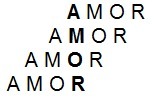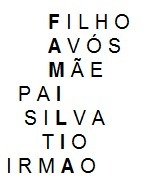Acrostic is a written composition made from the initial letters of isolated words or located at the beginning or inside of sentences and verses.
From the acrostics, which are read vertically, words or phrases are formed. They reflect a concern with the form of speech, which is why they are one of the resources used in the poetic function.
Types of Acrostics
There are several types of acrostics. The most common of them is the one formed from the initial letters of sentences.
 Acrostic of Friendship
Acrostic of Friendship
In addition to this, there are the following types:
alphabetical - when each sentence of the composition starts successively with a letter of the alphabet.
day by day
THEso my day starts,
BI stare, I get up, I have coffee.
Çlike in a dejavu, repetition.
Devade I continue my fight.
ANDfinding obstacles,
Froaring from inglorious tasks.
Gtaking our daily bread.
Htoday is a day to start over. Endless!
II introduce willpower to proceed,
JI love to give up, I insist, I fight, I resist.
Karaoke to ward off evils,
Lremnants of the life I once planned.
Mimportant moments, moments.
Nnever forgotten, saved.
Olaughing at my weaknesses,
Pbecause I need memories
QWhen depression approaches.
RI have insurmountable barriers.
sI know that I created them myself.
TI like cachaça to warm my body,
Uthen my lips to yours,
Vloves to our love nest,
Watts of energy in our bodies.
Xampu in your hair, flower smell.
Yoga you do it after hours of loving me.
Zhe loves me, and at the end of it all calls me love.
(Allan Ribeiro Fraga)
mesostic - when the letters that compose it are located in the middle of sentences.
 Acrostic of Love
Acrostic of Love
 Family Acrostic
Family Acrostic
Examples from First Name
It is very common to use the acrostic in tributes. Thus, based on someone's first name, the qualities or meaning that the person being honored has for the author of the composition or for those who want to pay homage are described.
Dr. Zilda Arns Neumann
Dand people like her our world is in need
Rindeed some personalities have a special gift
THEme to your neighbor our beloved Father is warning
Zilda Arns completed her journey here in our land
Iunfortunately his tragic death caused a lot of commotion
Lused as a brave soldier facing a war
Drest in peace is our desire with strong emotion
THE your glorious walk among us with victory ends
THE your fight for the needy serves as an example
Rlet us know that this woman did not die at random
Nyour smiling face much peace I contemplate
sin doubt she loved her neighbor as herself
(Forquilhinha, Santa Catarina - Brazil, August 25, 1934 — Port-au-Prince, January 12, 2010)
The acrostic was a resource used in cordel literature. But its origins go back to antiquity when the Greek monks used it for the first time. The objective was to register the names of its authors. Thus, they usually appear in the last stanza:
Leandro
Lector i didn't raise false
ANDI wrote what happened,
THEwhat a great success
NBahia happened,
Dthe way the old dog,
Rhello dead on the floor
Owhere your lord died.
(Last stanza of "The Dog of the Dead")
How is it done?
In addition to being a tribute, the acrostic can be a creative way to present the concept of something:
Positivism
Pmain creators: Comte and Mill
Oposition to the Middle Ages
surged as the sociological development of the Enlightenment
IInterpretation of Sciences associated with knowledge of ethics
Ttheory is only correct if proven by the scientific method
IKeyword: Three-State Law
Vtrue rationality in religion
Iinfluenced Brazil
sempathetic, real, right, helpful, accurate, organic
Metaphysical
Oset themselves to idealism and realism
The acrostic can also be used as a strategy for studying. When you need to memorize a rule or a formula, you can create a kind of acrostic that makes this memorization easier:
Lá noThe rwow xpsicologists onlyto thesomeiimportant ortwenty.
The sentence above recalls the rule of accentuation of paroxytones. The rule says that words ending in l, n, r, x, ps, ã (ãs, ão, aos), ums (um, us), i (s) and oral diphthongs are accented.
Now it's up to you. Create an acrostic, for example with your name, and be amazed by your creative ability!
Learn more about Poetic Function.
And what is Acronym?
While acrostic means "extreme of the line or of the verse", from the Greek acrostichís, acronym means "extreme of the name", from the Greek akronymos.
Acronyms are acronyms that can be pronounced like a word. Examples: NASA, UN, UNESCO.
